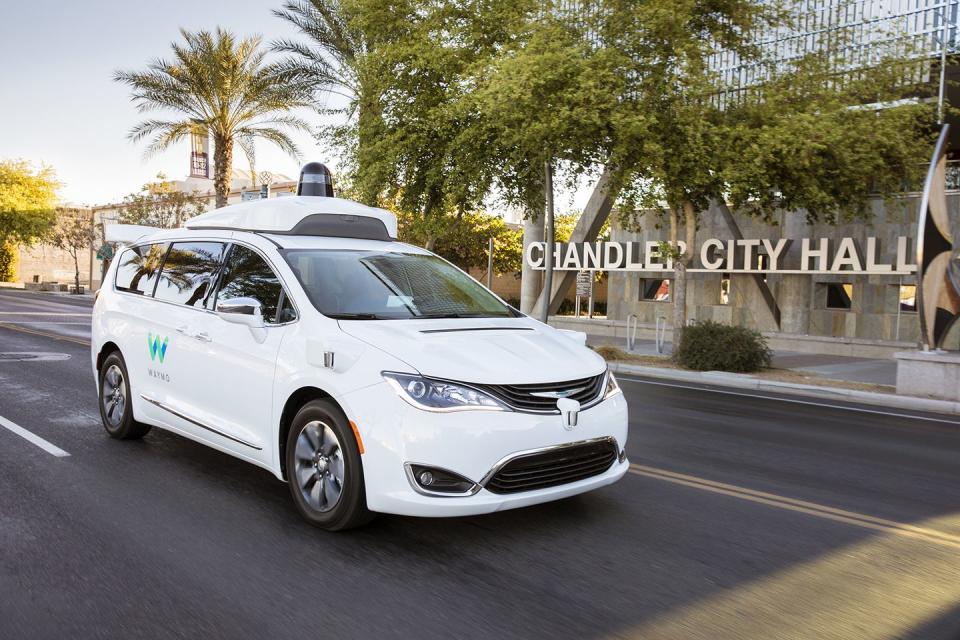Enemies of the Autonomous Vehicle: Workers, Hackers, the Weather

Sometimes when you are on the brink of a rebellion, it's hard to see what's happening around you.
Chandler, Arizona, has become a hotbed of attacks on autonomous vehicles (AVs). Over the past three years, people have assaulted self-driving cars in the city nearly two dozen times, pelting them with rocks, trying to run them off the road, challenging them to games of chicken, and slashing their tires. One man even threatened an AV with a .22-caliber revolver.
But police chief Sean Duggan says Chandler is "absolutely not" at the forefront of a rebellion between humans and machines. "These are anomalies within themselves," he says. "Each [perpetrator] has a different story. When you drill down and get to the person who's conducting this, there's a variety of other supporting issues of why they acted like that. Some may have lost their job, or it was just a bad day. Every story, every incident is different. I haven't seen any cause for concern that there is a movement, [that] there's something afoot, where these vehicles are being targeted."
Despite Duggan's assessment, we're less optimistic that these incidents don't speak to larger unrest about driverless cars. The facts suggest that these attacks are based on residents' fears and frustrations with the technology—concerns unlikely to be soothed anytime soon.

In 2016, Google's AV subsidiary, Waymo, brought its fleet of self-driving Chrysler Pacifica minivans to town. Hundreds of them now prowl the streets 24/7, collectively logging more than 25,000 miles per day. Until the spring of 2018, Uber was also testing its autonomous cars in the nearby city of Tempe. Then one of the company's test vehicles struck and killed a 49-year-old woman, Elaine Herzberg. The man who threatened a Waymo van with a gun expressed outrage over Herzberg's death. And other perpetrators said they were exasperated with the minivans' intrusions on the privacy and safety of their quiet neighborhoods.
Not much is being done to alleviate the fears of an anxious public. Waymo is planning on creating an AV traffic-safety program for kids, but without more government oversight of this technology, tensions are bound to increase, as people begin to organize around or against the massive disruption of a driverless future. No national or industry standards currently exist for the regulation of these vehicles. There is no infrastructure plan for their rollout or strategy for how human-driven vehicles and robocars will cohabit the road. And the Silicon Valley firms leading the tech bro-bot brigade have seen their credibility decline as issue after issue delays their projected AV Day Zero; as the problems to be "solved" become increasingly complex; and as some of their most heralded inventions, social media among them, morph into discontent-fostering megaliths. According to a AAA survey of public sentiment on AVs from earlier this year, nearly three-quarters of Americans expressed fear of riding in a self-driving car.
Organizations are already forming to protect the act of driving and defend against the more nefarious practices buried in autonomy. While these groups seem to be fueled by passion, many lack the "from our cold dead hands" stridency integral to other resistance movements. The Human Driving Association was founded in 2018 to advocate for making cars safer while protecting the freedom to own and drive them. Introduced via a 12-point "manifesto" published by The Drive, the organization now has nearly 10,000 members. Hagerty, one of the largest insurers of vintage and collectible cars, has launched a similar initiative. Called "Save Driving," it's dedicated to preserving the right of humans to drive and celebrating the joy that driving can bring, all while embracing lifesaving automotive technologies.
These groups worry about threats to personal freedom and privacy if the right to drive is denied to humans. They are concerned with the degrading effect that data-driven, data-deriving self-driving cars may have on society. They worry that the deployment of automated vehicles may further enhance national divisions: for example, those between urbanites—whose densely populated, meticulously mapped cities will be great candidates for autonomy—and outlying rural areas that likely won't have access to the technology. Given that the eventual goal for AV integration is to have all driverless cars connected and speaking the same language, these organizations also fear that the technology will end up being owned entirely by one entity—Google, Amazon, Uber, GM—that capitalizes on our reliance to mine our data and market its products.
These are dystopian fears that not everyone has. In ending our conversation with Duggan, we bring up this very threat, that of evil, monopolizing megacorporations—like Skynet from The Terminator and, perhaps a bit panderingly, Omni Consumer Products from RoboCop—as speculative possibilities for where the AV narrative could go in Chandler.
"I'm not a sci-fi guy," Duggan says coolly. "I don't really watch those movies. I've been policing for 33 years. Anything's a possibility. But I'm not really preparing for that."
The Workers
Autonomous vehicles are increasingly finding opposition among America's nearly 4.5 million professional drivers, an occupation that represents almost 3 percent of our workforce. Uber and Lyft, the United States Postal Service and UPS, and private and public bus services are all working fiercely on AVs to replace human operators. The tech may arrive first in long-haul trucking. California's TuSimple is already operating self-driving tractor-trailers, hauling commercial freight on public highways in Arizona. Safety drivers are onboard for now. But according to Chuck Price, TuSimple's chief product officer, the company plans to deploy fully driverless 80,000-pound semis by the end of 2020.
International Brotherhood of Teamsters president James Hoffa Jr., whose union represents 1.4 million workers, is clearly worried about his members' jobs. And he's concerned about the wisdom of removing highly trained, professional union drivers from the road and replacing them with unproven tech. "Would you fly on an airplane with no pilot or co-pilot?" he asks. "The answer is no. Could it be done? Yes."
Hoffa suspects that the true motive for AVs has little to do with safety or fuel-efficiency gains or the alleged driver shortage touted by fleets. "I think the whole idea is that they want to save money," he says. "They want to get rid of the human element. And that's what's wrong, and that's why we have unions, to protect workers."
Hoffa doesn't seem like a Luddite. He recognizes that his 116-year-old union—whose logo features a team of harnessed horses, from when its members used draft animals to move goods—will need to adapt. He's also aware that technological change often creates new ancillary jobs. But he advocates for human-focused planning. To this end, he proposes that money saved by the industry be placed in a fund to be used for training displaced drivers for careers in new fields. He also suggests guaranteeing redundant workers the opportunity to fill the jobs that emerge due to automation. "We want the future to include workers," says Hoffa. "We want to make sure that workers have a better life. Not go the other way, where they're displaced and don't have jobs. It isn't about whether you can make money. You just can't throw these people into a scrapheap."
Price claims that when these technologies actually arrive, the rollout will be slow. TuSimple and other AV companies have begun to partner with local colleges to provide job-training programs aimed at delivering fresh (nonunion) technical workers into their pipeline. But little broad thought (or policy proposals) has been given to mitigating the potentially immense workforce shifts that AVs may bring.
The Hackers
Douglas Rushkoff, a media-theory professor at the City University of New York and progenitor of the terms "digital native," "viral media," and "social currency," was prescient in imagining public backlash to a robotized world populated by signs and signals that are readable only by machines. "When they were first talking about autonomous vehicles 10 years ago," Rushkoff says, "I imagined posses of skateboard kids going out at night with spray cans and redrawing street lines to get [AVs] to drive off cliffs or go in circles."
Hackers are already exploiting these new languages. White-hat researchers at Tencent Keen Security Lab in China recently found a simple way to trick the driver-assistance systems in a Tesla. Since these vehicles see and interpret differently than humans do, the introduction of seemingly innocuous signals—in this case, small stickers placed in a roadway—were enough to convince the car to change lanes right into oncoming traffic.
This leads us to one of the most fearsome features of AVs: their capacity to be compromised by rogue actors. Cars could be taken over remotely and manipulated, militarized, or held hostage for ransom. According to David Barzilai, co-founder of automotive cybersecurity firm Karamba Security, "There's a consistent pattern. When systems become connected, they get hacked."
This vulnerability to hacking increases with the quantity of code contained in the product's software. A commercial jet has 15 million lines of code. A contemporary luxury car has 100 million. An autonomous car is estimated to have more than 300 million.
"Hacking today is business," says Barzilai. "It's driven more by money, less by fear. In order to gain the profit of the hacking attempt, you need to make the threat, demonstrate the threat, but not do irreversible damage. And it's more to frighten the OEMs, not the consumers. The idea is to tell the OEMs, 'I have the capability to shut down your fleet. If you don't believe me, watch me shut down a few cars in a random suburb.' "
"So, are we doomed?" we ask Barzilai.
He pauses for a moment. "I would say yes."
The Weather
When we recently drove a Cadillac CT6 equipped with the brand's sophisticated Super Cruise hands-free driver-assistance tech, we ran into a bit of trouble. No matter how many times we tried to engage the system, in whatever appropriately geo-mapped highway location we were in, it would not take. When we confronted a Cadillac employee about this, he suggested that the problem might be that it was "too sunny."
Weather and visibility play key roles in the functionality of the suite of cameras and sensors required for driverless cars to "see." "Lidar is extremely sensitive to particles in the air," says Price. "Rain or sand or fog refracts the laser beam as it's traveling out, meaning the signals either get lost or return distorted and unusable. Cameras, on the other hand, are quite resilient to weather, to snow and rain, until it gets extremely heavy" and their lenses get blocked.
Suppliers are developing workarounds. Wipers, heated shields, and specially treated surfaces are used to prevent precipitation buildup. Artificial-intelligence systems are trained to interpret and identify objects distorted by weather. Vehicle-control algorithms are designed to enhance on-road stability. And remote operators maintain oversight, monitoring environmental conditions and rerouting vehicles before they enter areas that are beyond their operational design domain.
Autonomous cars are also being trained to monitor themselves and respond accordingly. "So if visibility drops below a certain point, they go into a degraded mode where the vehicle automatically pulls over to the side of the road," says Price. "Or, depending on the severity, it may just decelerate and find a safe location along the mission route."
Lines of idling, unmanned, unguarded trucks hemmed in by weather and filled with valuable goods. Does anyone else see the plot to a heist movie?
You Might Also Like

 Yahoo Autos
Yahoo Autos 